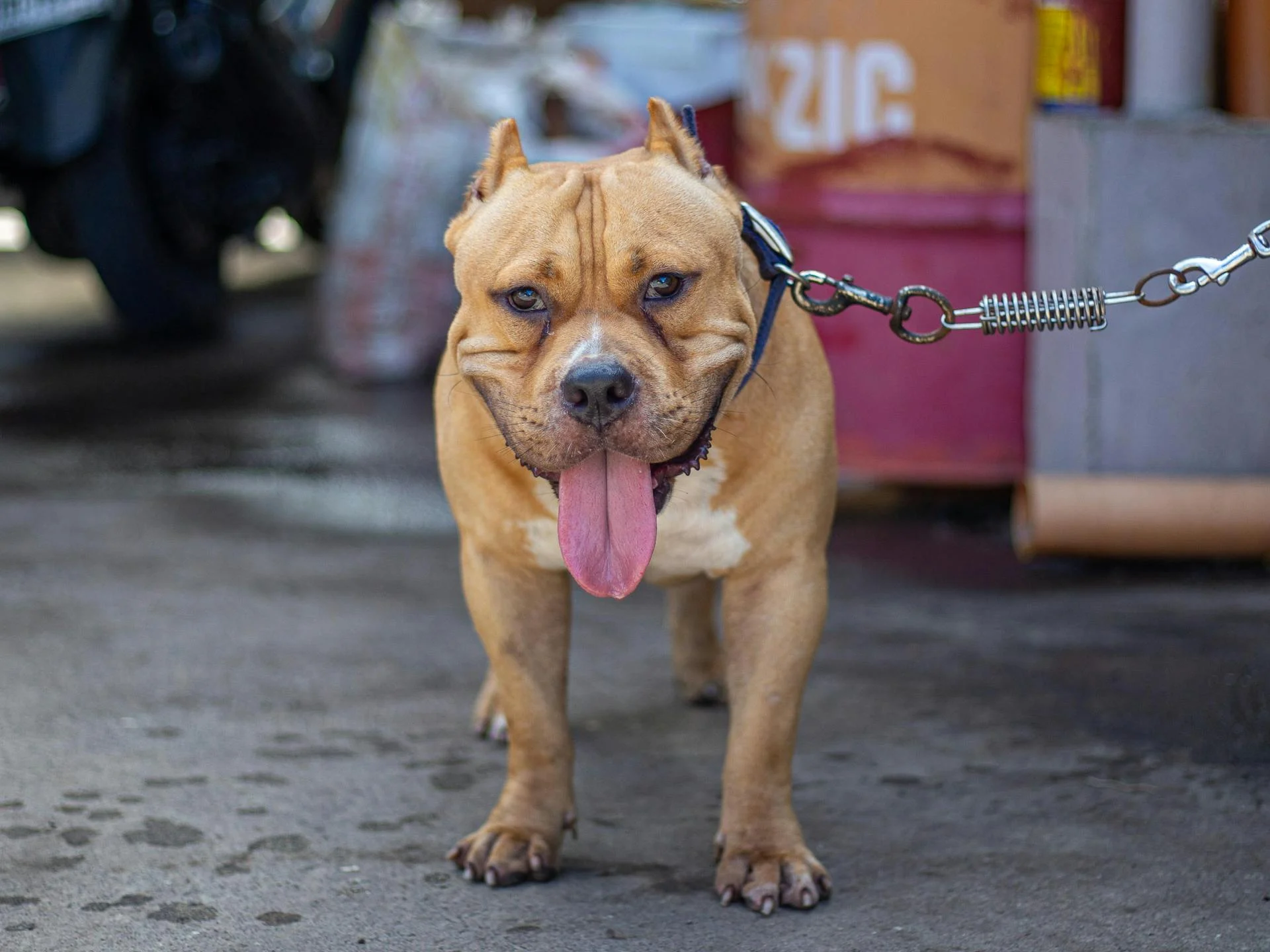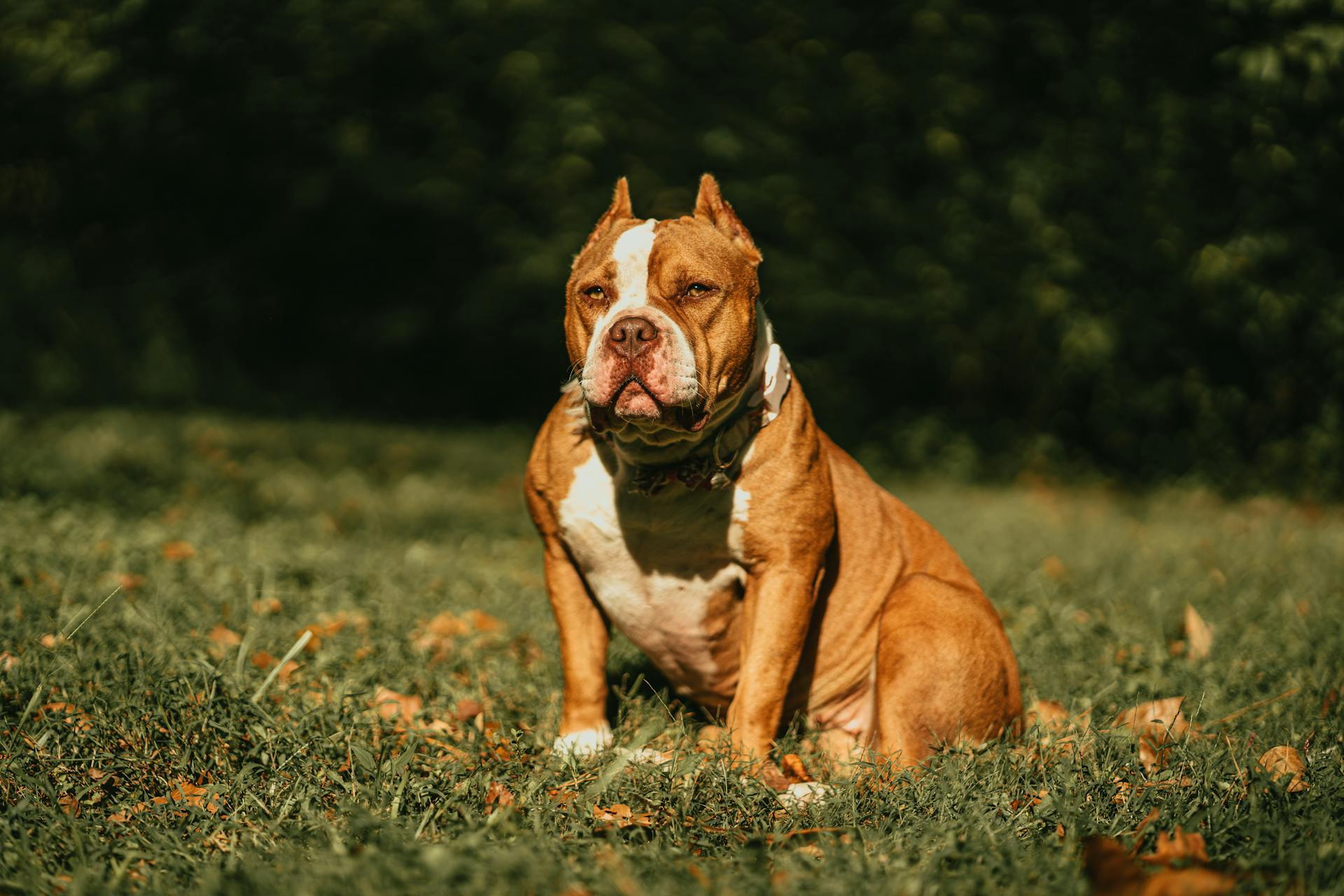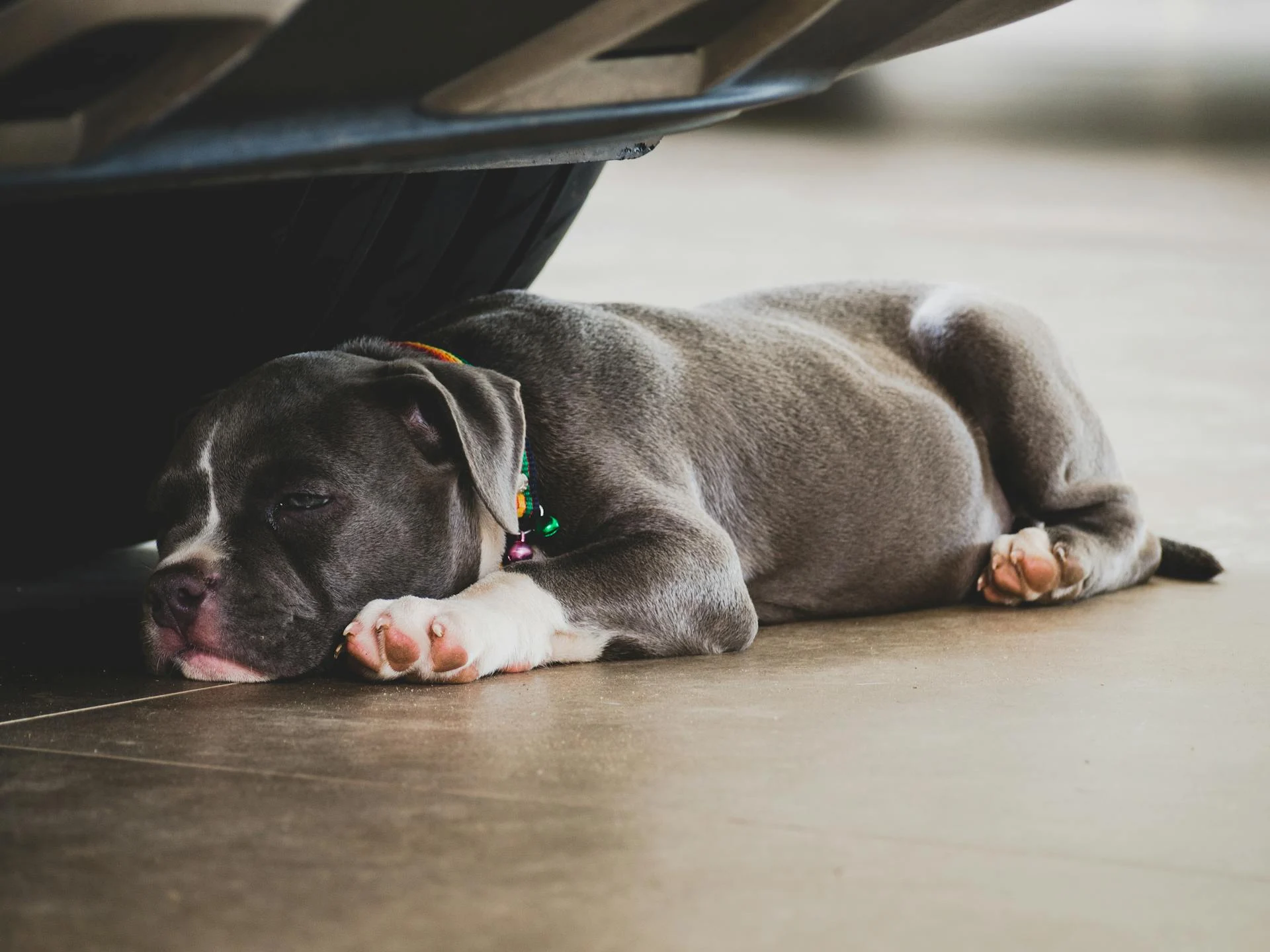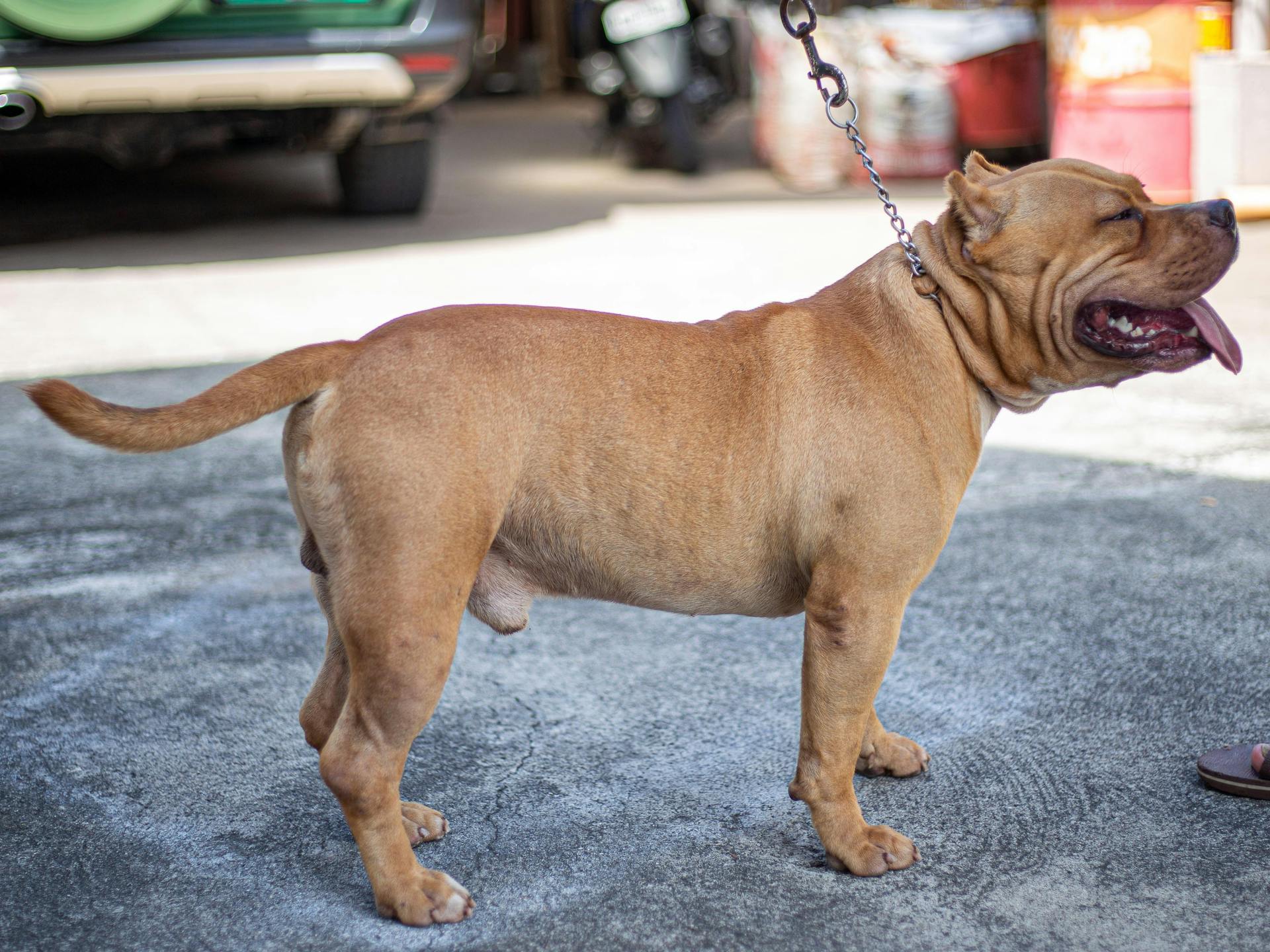
The American Bully and Pitbull breeds are often confused with each other, but they have distinct differences. The American Bully was developed in the 1990s as a companion dog, while the Pitbull has a long history dating back to the 19th century as a working dog.
One of the most notable differences between the two breeds is their physical appearance. The American Bully comes in four different sizes: standard, pocket, classic, and XL, while the Pitbull is typically medium-sized.
Both breeds are known for their strength and athleticism, but the American Bully is generally more laid-back and affectionate, while the Pitbull is often described as energetic and playful. The American Bully also tends to have a more muscular build than the Pitbull.
You might like: American Bully Back Leg Problems
Historical Context
The American Bully was officially recognized as a breed in the 1980s, making it relatively new in the dog world. It was bred primarily as a companion animal, a stark contrast to the origins of many other breeds.
The American Pit Bull Terrier has a much older lineage, tracing its roots back to the early 1800s in the UK.
The American Bully originated from a mix of the American Pit Bull Terrier and other breeds, which might explain some of the physical similarities.
American Pit Bull Terriers were initially bred for bull-baiting and later for dog fighting.
The American Bully and American Pit Bull Terrier have different backgrounds, although they still have somewhat similar histories.
Broaden your view: American Bully Staffy Bull Terrier
Physical Characteristics
The American Bully boasts a robust and muscular frame, with a stockier build and a broader skull compared to its shorter legs.
The breed is categorized into four sizes: Pocket, Standard, Classic, and XL, each with subtle differences in build.
The American Pit Bull Terrier, on the other hand, has a leaner and more athletic build, with a wedge-shaped head and longer legs.
They possess almond-shaped eyes and ears that can be either cropped or natural.
The Pitbull typically stands between 17 and 21 inches tall from paw to shoulder and weighs between 30 to 65 pounds.
This makes them a medium- to occasionally large-sized dog, perfect for most family households.
The Bully dog is broader and shorter than he is tall, resembling an English Bulldog in appearance but with more muscle.
Many people are intimidated by them due to their history and scary-dog appearance, but they're apparent softies just by looking at their ear-to-ear smiles!
Discover more: American Bully Ear Infection
Temperament and Behavior
American Bullies are known for their affectionate nature, being friendly, confident, and extremely loyal to their families.
They get along well with children and other pets, making them excellent household companions.
Despite their intimidating appearance, American Bullies are calm dogs with a lower prey drive, making them much more social and stable.
They are docile and laid-back, rarely getting upset about anything, and are generally considered much easier dogs for beginners.
American Pit Bull Terriers, on the other hand, can exhibit dog aggression if they aren't socialized on time, despite being affectionate, intelligent, and eager to please.
They have a protective instinct, making them both loyal companions and effective guard dogs.
American Bullies were bred to be calmer dogs, with a goal of selecting against aggressive tendencies, but unfortunately, a percentage of the breed may display unexpected aggression.
This is also true for American Pit Bull Terriers, which have been involved in a disturbing number of attacks on humans and other animals.
Health and Grooming
Both American Bullies and Pitbulls are generally healthy breeds, but they can be prone to certain health issues. American Bullies may face joint issues, heart conditions, and skin allergies, while Pitbulls might be susceptible to hip dysplasia, skin issues, and hereditary cataracts.
Regular grooming is essential for both breeds. They have short, straight double coats that are soft to the touch, but they still shed moderately. Brushing them once every few days can help keep loose hairs at bay, and bathing them every few months is sufficient, unless they get dirty.
Some common health concerns for both breeds include elbow and hip dysplasia, skin infections, ear infections, eye problems, and allergies. Obesity is also a concern, especially since they tend to be voracious eaters.
Related reading: American Bully Food Allergies
Health
Both American Bullies and Pitbulls are generally healthy breeds, but they can be prone to specific health issues. American Bullies are susceptible to joint issues, heart conditions, and skin allergies.
Hip dysplasia is a common health concern for both breeds, with Pitbulls being more likely to develop it. This can lead to severe arthritis in later life and even dislocate the hip.
Elbow and hip dysplasia, skin infections, ear infections, eye problems like cataracts, allergies, and certain types of cancer are shared health problems between the two breeds.
Obesity is another issue that affects both breeds, especially since they tend to be voracious eaters. Regular exercise and a balanced diet can help prevent this.
American Bullies are particularly prone to brachycephalic syndrome due to their Bulldog ancestry and flat faces, which can lead to breathing difficulties.
With proper care, including regular vet visits and a healthy diet, both breeds can live long and happy lives.
Curious to learn more? Check out: American Bully Dog Health Problems
Grooming
Both American Bullies and Pitbulls have short, straight double coats that are very soft to the touch, often described as silky or like velvet.
You'll need to brush them regularly to keep loose hairs at bay, ideally once every few days, to prevent excessive shedding.
Don't go overboard with bathing, as it can lead to itchiness and damage, and instead aim for every few months, or more often if necessary.
Brushing them once a week can help disseminate natural coat oils, get rid of dead hair and grime, and is a peaceful moment to spend with your dog.
Both Bullies and Pitbulls shed on average, but don't blow their coats on a seasonal basis, which is a relief for many owners.
A simple bristle brush is an excellent choice for brushing both of these breeds.
They should get baths once every two to three months, or as and when they require it, especially if they get muddy on their walks.
Curious to learn more? Check out: American Bully Coats
Training and Care
Training and care are crucial aspects of owning an American Bully or Pitbull. Both breeds benefit from early socialization and positive reinforcement-based training.
The American Bully might be slightly easier for first-time dog owners to handle due to its more laid-back nature. However, consistent training and mental stimulation are still necessary to keep it happy and balanced.
Positive reinforcement training is essential for both breeds, and treats can motivate the Bully, while toys can motivate Pitbulls. Both dogs yearn for human company.
To keep your Bully happy and healthy, ensure it has a securely fenced yard for exercise and engage its body and mind with activities like backyard games, obedience, and scent work.
Additional reading: How to Train an American Bully
Training and Socialization
Both breeds benefit from early socialization and positive reinforcement-based training. This is especially true for first-time dog owners, who may find the American Bully's laid-back nature easier to handle.
The American Pit Bull Terrier requires consistent training and mental stimulation to stay happy and balanced. Consistent training can help burn off excess energy and keep them focused.
Curious to learn more? Check out: American Pitbull Terrier Training
Pitbulls are clever and eager to please dogs that respond well to training. With a bit of research on dog training, new owners can easily train a Pitbull.
Positive reinforcement training is a great way to train both breeds. Treats are likely to motivate the Bully, while toys are likely to motivate Pitbulls.
Both dogs need to be properly socialized from the start. A good breeder will often begin teaching socialization before the dog even goes home.
Care and Upkeep
The American Bully is not a pet for dog parks due to its power and potentially aggressive nature, so a securely fenced yard is a must.
It needs regular exercise, which should include leash walks and activities that engage both its body and mind, such as backyard games, obedience, and scent work.
Bullies love playing with balls, but they're not driven to retrieve, and they're not enthusiastic swimmers either.
In fact, they're not very good at swimming, which is something to consider if you live near a body of water.

Coat care is minimal, consisting of occasional bathing and brushing, which is great news for busy owners.
However, they do need to avoid extreme cold and heat, so they're best suited for moderate climates.
Adult Bullies need no special dietary consideration beyond a well-balanced and nutritious diet, but it's essential to feed them a large breed puppy food if you have a larger variety to slow down their growth and reduce the risk of hip dysplasia.
Hip dysplasia is a significant concern in the breed, with 43 percent of tested American Bullies affected, which is much higher than most breeds.
Elbow dysplasia is also a problem, with 38 percent of tested American Bullies affected, so it's crucial to take preventative measures.
Brainstem auditory evoked response (BAER) testing is recommended for puppies, especially those with a majority of white in their coat, to detect pigment-related deafness.
Breathing problems associated with brachycephalic airway syndrome are also a concern, so it's essential to monitor your Bully's breathing and take action if you notice any issues.
Here's an interesting read: Purebred American Bully
Key Differences and Comparison
American Bullies and Pitbulls are often confused with each other due to their similarities, but they have distinct differences. One key difference is their origin, with Pitbulls being the result of crossbreeding Terrier breeds and Old English Bulldog, whereas American Bullies are a crossbreed of Pitbull.
When it comes to size, American Bullies are generally smaller, with a height range of 13-20 inches, compared to Pitbulls, which can reach 14-24 inches. Weight-wise, American Bullies tend to be heavier, with a weight range of 50-100 pounds, while Pitbulls typically weigh between 30-80 pounds.
Here's a comparison of the two breeds in a table:
In terms of temperament, American Bullies are known for being friendly, playful, and gentle, while Pitbulls are social, playful, and territorial. Both breeds are suitable for families with kids, but proper socialization is essential.
Physical Differences
Physical differences between Pitbulls and American Bullies are noticeable once you know what to look for.

Pitbulls are medium-sized dogs with a short coat that comes in more than 30 colors. They have a light weight and a much slimmer body.
Their height is typically between 14 and 24 inches, and they weigh 30 to 80 lbs – although most will have a weight of around 60-65 lbs.
American Bullies have a broader build with larger heads and shorter legs. They have a muscular build that gives them an athletic appearance.
While the average Bully height is between 13 and 20 inches, they weigh more than Pitbulls, considering how they can easily reach 100 lbs.
Here's a comparison of the two breeds' sizes:
American Bullies come in varying sizes, including the Micro Bully, Pocket Bully, Standard Bully, Classic Bully, American Bully XL, and American Bully XXL.
Key Differences and Comparison
American Bullies and Pitbulls are often confused with each other, but they have some key differences.
One of the main differences is their origin: Pitbulls are the result of crossbreeding Terrier breeds and Old English Bulldog, while American Bullies are a crossbreed of Pitbull. This difference in ancestry affects their physical characteristics, with Pitbulls typically weighing between 30-80 pounds and standing 14-24 inches tall, while American Bullies can weigh between 50-100 pounds and stand 13-20 inches tall.
For another approach, see: American Bully Pocket Pitbulls

In terms of temperament, both breeds are friendly and social, but Pitbulls are also known to be territorial, while American Bullies are generally gentle.
Both breeds are suitable for families with children, but it's essential to socialize them properly to ensure they get along.
Here's a comparison of the two breeds in a table:
In terms of exercise needs, Pitbulls require a lot of physical activity, while American Bullies need only moderate exercise. Both breeds are highly trainable, but it's essential to keep in mind that they have different energy levels and exercise requirements.
Comparison of Strength
American Bullies have a muscular build and large body mass, which gives them a physical advantage. They are also estimated to have a bite force between 200 and 305 psi.
Pitbulls, on the other hand, are known for their agility, which can be a significant advantage. Their bite force is estimated to be around 235 to 250 psi.
A unique perspective: American Bully Bite Force Psi
While American Bullies might have a slight edge in terms of bite force, it's essential to note that there isn't enough research to confirm this. Pitbulls' agility and strength make them a formidable opponent.
Both American Bullies and Pitbulls are equally strong, which is beneficial if you're using them as working dogs.
Frequently Asked Questions
What makes a bully PitBull?
What makes a Bully Pitbull is its unique blend of breeds, including American Staffordshire Terrier, American Pit Bull Terrier, and Bulldog, which creates a loyal and affectionate companion
What two dogs make a American Bully?
The American Bully breed is a combination of the American Staffordshire Terrier and the American Pit Bull Terrier. This mix of breeds has resulted in a unique and versatile companion dog.
How do you know if your dog is an American Bully?
Your American Bully's compact, strong build and thick-set structure are key indicators of the breed. If your dog's appearance reflects a Pit Bull Terrier foundation with other bull breeds, it may be an American Bully
Are all bully breeds Pitbulls?
No, not all bully breeds are Pitbulls. While Pitbulls are a type of bully breed, the term 'bully breed' encompasses a broader range of dog breeds, including Bull Terriers, Bullmastiffs, and others
Is an American Bully an aggressive breed?
American Bullies are known for their gentle and friendly demeanor, making them an excellent family dog. Aggressive behavior towards humans is not characteristic of the breed.
Sources
- https://www.bgmwarehouse.com/blogs/bully-breeders-hacks-tips-interviews/american-bully-vs-american-pit-bull-terrier-differences
- https://breedatlas.net/american-bully-vs-pitbull/
- https://thepawsjournal.com/dog-breeds/american-bully-vs-pitbull-is-there-a-difference/
- https://dogseatrite.com/american-pit-bull-terrier-vs-american-bully-understanding-the-differences/
- https://www.britannica.com/animal/American-Bully
Featured Images: pexels.com


